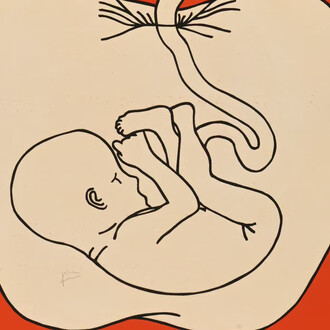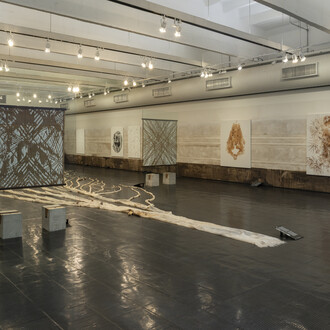A barn in flames. A dream-memory. A hazy atmosphere. Silence and time suspended. The scene is captured in a slow, extended shot as the camera gradually approaches. A long take of the character silently crossing the field, coming upon the barn completely engulfed in flames, being consumed by fire. The sound of the cracking wood dissolving in flames and the gray smoke enveloping the place, and her waiting, motionless before the inevitable collapse, revering what is greater than her smallness. The scene, taken from Andrei Tarkovsky’s The mirror, reflects his cinematic path of visual meditation. In the face of time, transformation, and the fragility of life, the flames condense, and what remains is the perception of contemplation, the collision between the inner mental dimension and the outer world. Dimly reflected is the in-between, oscillating amid the visible and the hidden, in translucent layers that complete themselves with each attentive gaze, a reflective relation to glazing and to the murky capacity of perception. Confronted with João Trevisan’s material ensemble, we are summoned to experience the stretching of time. Like the character, we do not run to extinguish the fire; instead, we feel an eruptive calm that evokes a contemplative presence — the body before the matter. Trevisan sculpts time and hypnotizes, as Tarkovsky does.
Trevisan operates through the elongation of perception, working in partnership with matter, he forges, ambushes his technique, and refines his own language. There is a compositional reflection at play in his work, the image dissipates and envelops the gaze, which wanders through brightness. Light emerges like a music score, with each painting emitting a vibration. The exhibition grants us access to five series from his body of work, some of them previously unseen — Concomitante, Paisagens, Unidade luminosa, Monocromo and Intervalos. These are compositional acts of a grand motif, like in an opera, all referring to the same universe, in dialogue as pairs and coherently with the complete piece. The series are intimately interconnected: in 2018, he painted his first Monocromo, the same year as his first Intervalo, revealing the unfolding of his process. It unfolds in a non-linear, branching manner, there is no center or hierarchy, yet, paradoxically, everything is central. The dense blocks of color are bound by texture, each one extending from the other.
In the face of a contemporaneity where everything is disposable, instantaneous, and compressed, time becomes stretched and to embark into the luminosity of painting is to expand the realm of the senses. João Trevisan invites us to inhabit a space of silence and contemplation by anchoring painting within dilated time.
The titles offer seemingly straightforward information with curious touches, at times direct, at times playful. On the backs of the works, delightful surprises await: traces left by the artist that draw us closer to his presence, such as in Intervalos, in the mornings, I miss you.
The gradations of color vary in depth, showing higher or lower opacity, with deeper layers showing through and interfering with each other. We note the artist's technical prowess, in which the colors, even when always used in the same way, are always different, whether the blacks will complement or interfere with the covering colors, or appear or dissolve, and indicate a co-participation between the oil paint and the velvet created by the encaustic.
It uniquely inserts small challenges to the eye, certain purposeful irregularities, as in Concomitantes. Subtle shifts, such as a small margin at the beginning of a paragraph, show a rationality in thinking about the work in a calculated way, but not only that, there is something intuitive about the relationship of the colors, the process of making is methodical, from the depth of the chassis to the finish. This game of perception is only created in contact with the viewer, who notices the slippage of the shapes, evidencing the propositional force of the artist in his rhythmic chromatic waves.
The canvas is dense, starting with crossed layers of plaster, diluted to the point of thickening, adding body to the process, and then followed by the addition of ten to twelve layers of black. He overflows the texture and articulates the body of the painting through the habit of repetition. When dry, the surface is veiled, a diaphanous covering with black, in which the colors subtly become invisible, and with the subsequent cleaning, the pictorial body rises to equilibrium. He removes the excess, deposits light, deposits pigment, sculpts the body of the painting by shaping its relationship with light. He creates a process of waxing the painting, in which the gaps are filled in by the black, making it possible to perceive the residual luminosity coming from the white base, revealing the process of retraction of the pigment as it dries, when its particles thicken and come closer together, partially revealing the background.
There is a willingness derived from sculpture, from a poetic cycle that emerges from the paper, returns to the sculptures and hatches in the paintings. The lines are handled in the three-dimensional as well as the two-dimensional, their pictorial texture rises up as a form in the sculptural field. He models fibers of paint, creating a luminous illusion through volume. There is a certain enigmatic aspect to trying to decipher where the color comes from and where the chromatic spark goes. It engenders a repetitive method that borders on Buddhist meditation, repeating the process, repeating the form, repeating the preparation and the layers. The relationship with the painting is corporeal, in which the artist's gesture is prolonged and what we see is the blurred reflection of Trevisan's overflow.
The artist is crossed by life outside the studio, he conducts his work through urban contaminations, the capital of the country, Brasília, is not only his home, but it is also the habitat of the painting. When dry, the city's landscape reveals an earthy red, the cerrado in its genuine constitution, the native cradle of the Pequi and Baru trees. Sometimes he visualizes a less arid air, a more organic and nourishing moment - Trevisan is permeated by these manifestations, he allows himself to be infiltrated.
Perception is in the sensory field, his practice is completed by activating the viewer's gaze, which ceases to be external and becomes a constituent part of the projection of colors, the quintessential encounter between the material body and the sensitive body. We are summoned to approach and move away from the works, so that Trevisan provides a visual experience of immersion in his universe, an emotional way of being in front of his contour. Pictorial making is an attentive conversation between matter and poetic making; the application of color is as important as the choice of color. The coincidence of opacity with brightness and the meeting of encaustic with the volume of oil reveals how the painting retains traces of the instrument and the gestural performance with the material; the artist is undoubtedly bonded to the desires and aspirations of the material.
A rhythmic pulse in the shapes that are repeated in the construction of materials, in the displacements and spaces, in the power of the presence of colors over others. Trevisan's poetics is a flame that spreads through the barn, not as destruction but as a process of dissemination. It becomes charcoal, soot and smoke that spreads through the environment, dissipating into fog in a subtle way. The mist trail is a potency, what can be seen and felt is gradually veiled and transmuted, covering the landscape, interrupting perception and summoning a pause. Surrendering to time and waiting for what is elusive to the eye to be revealed is how we experience dimly reflected.
The veiling in the surface is the mist branching out through the exhibition space, a rhythmic bond that emanates from all the works, the locus of painting is always revisited, articulated in so many other possibilities, which cyclically return and complement each other. As we embark on his poetic practice, we notice nuances, subtleties of the painting's quality that are consolidated in the gaze of those who come across his geometrizing landscapes and, in Dimly reflected, we become absorbed in a luminous and contemplative occupation by João Trevisan.
(Text by Mariane Beline)















